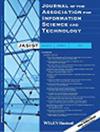Bibliometric information retrieval system (BIRS): A web search interface utilizing bibliometric research results
Journal of the American Society for Information Science and Technology
Pub Date : 2000-11-01
DOI:10.1002/1097-4571(2000)9999:9999%3C::AID-ASI1031%3E3.0.CO;2-B
引用次数: 49
Abstract
The aim of this article is to test whether the results obtained from a specific bibliographic research can be applied to a real search environment and enhance the level of utility of an information retrieval session for all levels of end users. In this respect, a Web-based Bibliometric Information Retrieval System (BIRS) has been designed and created, with facilities to assist the end users to get better understanding of their search domain, formulate and expand their search queries, and visualize the bibliographic research results. There are three specific features in the system design of the BIRS: the information visualization feature of the BIRS (cocitation maps) to guide the end users to identify the important research groups and capture the detailed information about the intellectual structure of the search domain; the multilevel browsing feature to allow the end users to go to different levels of interesting topics; and the common user interface feature to enable the end users to search all kinds of databases regardless of different searching systems, different working platforms, different database producer and supplier, such as different Web search engines, different library OPACs, or different on-line databases. A preliminary user evaluation study of BIRS revealed that users generally found it easy to form and expand their queries, and that BIRS helped them acquire useful background information about the search domain. They also pointed out aspects of information visualization, multilevel browsing, and common user interface as novel characteristics exhibited by BIRS.文献计量学信息检索系统(BIRS):利用文献计量学研究成果的网络检索界面
本文的目的是测试从特定书目研究中获得的结果是否可以应用于实际的搜索环境,并提高信息检索会话对各级最终用户的效用水平。在这方面,我们设计和建立了一个基于网络的文献计量信息检索系统(BIRS),该系统的设施可以帮助最终用户更好地了解他们的搜索领域,制定和扩展他们的搜索查询,并将书目研究结果可视化。在BIRS的系统设计中有三个具体的特点:BIRS的信息可视化特征,引导最终用户识别重要的研究群体,获取搜索领域的智力结构的详细信息;多层次浏览功能,让最终用户可以浏览不同层次的有趣话题;以及通用的用户界面特性,使最终用户能够搜索各种数据库,而不管不同的搜索系统、不同的工作平台、不同的数据库生产商和供应商,如不同的Web搜索引擎、不同的图书馆opac或不同的在线数据库。一项对BIRS的初步用户评价研究表明,用户普遍认为BIRS很容易形成和扩展他们的查询,并且BIRS帮助他们获得有关搜索域的有用背景信息。他们还指出BIRS具有信息可视化、多层次浏览和通用用户界面等新特点。
本文章由计算机程序翻译,如有差异,请以英文原文为准。
求助全文
约1分钟内获得全文
求助全文
来源期刊
自引率
0.00%
发文量
0
审稿时长
3.5 months

 求助内容:
求助内容: 应助结果提醒方式:
应助结果提醒方式:


